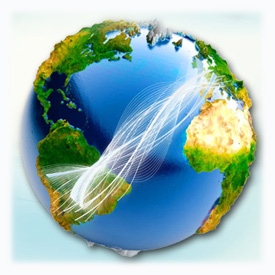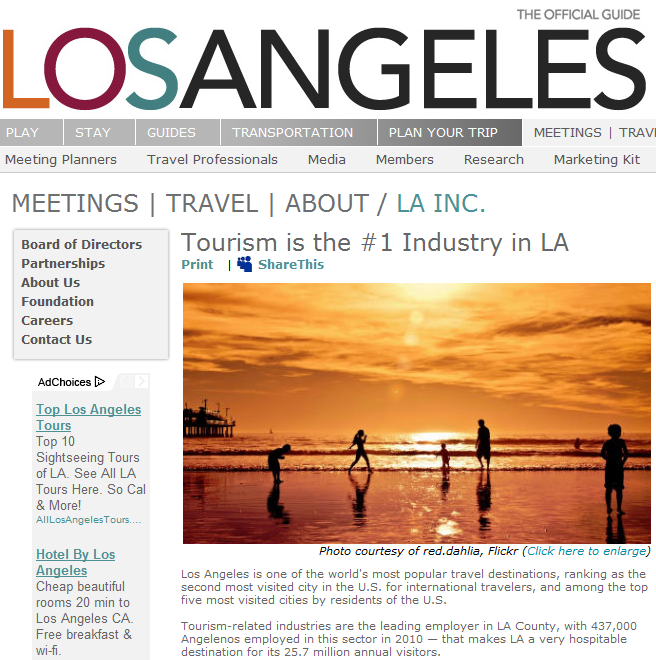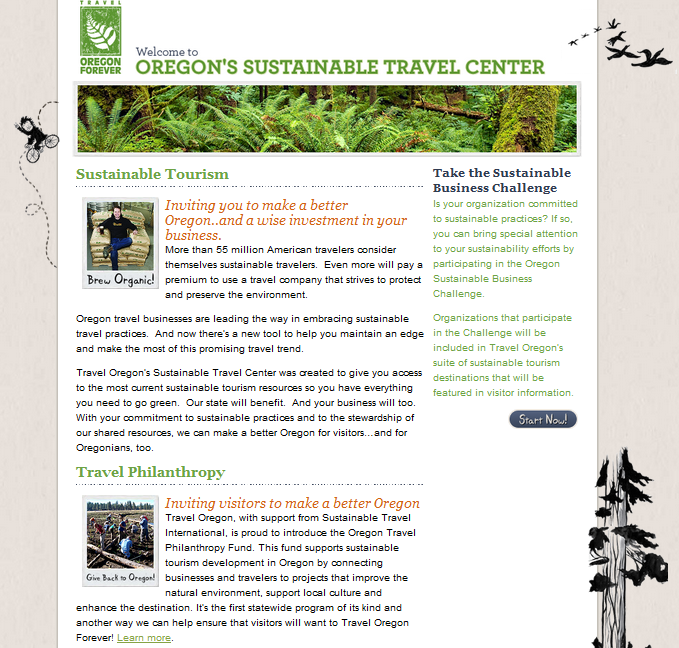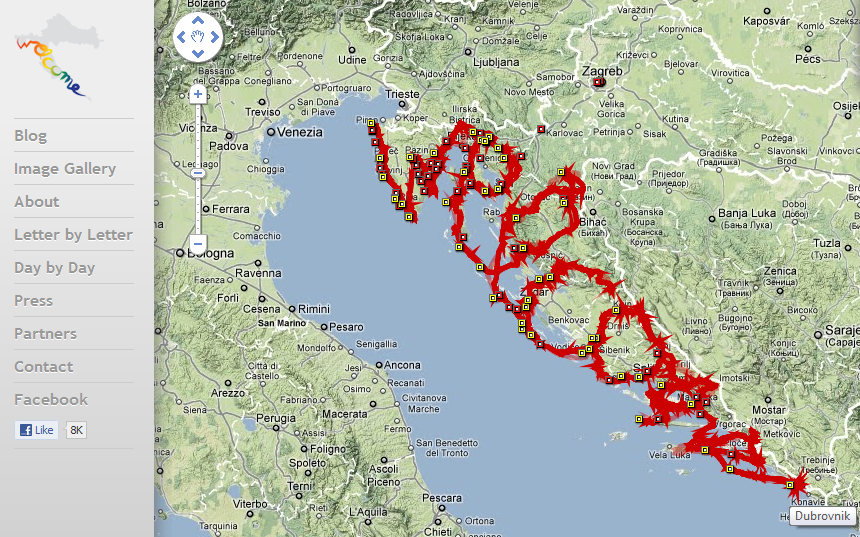Innovative Destination Development & Marketing Initiatives - You can do it!
Amid fierce competition for tourism receipts, certain destinations take a more proactive approach addressing the issues their tourism industry is facing, in order to stay ahead of their competitors and overcome various obstacles.
So what can you do when the destination's marketing budget is just not enough? or when the destination's image proposition is not met by the community's tourism acceptance? how do you combine destinations with common objectives and common issues? how can you elevate your local branding when there is negative destination publicity? are you truly "green" and how can you prove it?
Let's see how a selection of various destination initiatives shows the way to innovation to tackle some hot issues and get inspired...
Need more marketing funds?
Los Angeles is the most recent adopter of a Tourism Marketing District, following a large number of California destinations to implement this initiative in order to provide a stable funding source for tourism promotion. The citywide Tourism Marketing District (TMD), is a sustainable new funding stream that is projected to yield an estimated $11 million a year to market Los Angeles to business and leisure travelers. The City Council gave its unanimous approval, after strong support from city leaders and LA's hotel industry.
TMDs are an increasingly popular method to expand marketing budgets, having been adopted by more than 55 cities in California alone in recent years. The TMD will be funded entirely by hotel visitors through a 1.5 percent assessment at mid-sized and large hotels in the city and will be administered by LA INC. The Los Angeles Convention and Visitors Bureau.
“This is a great investment in our city’s top industry that supports jobs and economic development,” said Bob Amano, Director, LA Hotel Association. “By collectively adopting this small assessment, hoteliers as a community can have a much greater impact when it comes to increasing occupancy than any of us could accomplish individually.” Hotel owners are confident the 1.5% assessment will not adversely impact current or future business.
How does your community accept tourists?
St. Louis recently launched an initiative to tackle an issue they found out to affect the visitor's image of the city. In order to banish the image of the discourteous, anti-social taxi driver, the St. Louis Convention and Visitors Commission recently instituted mandatory training sessions for each of the approximately 2,500 drivers plying city streets. Those drivers that do not complete the training will risk losing their taxicab license.

“Taxicab drivers really are ambassadors for St. Louis,” said the CVC’s Lorraine Gustavis, who administers the training sessions. “They’re the first face that people often see when they come to our region. So we want to make sure that we’ve given them everything to be equipped to deliver exceptional service.”
Topics covered in the session include being courteous to the customers, keeping a clean cab and personal appearance, and being up-to-date on current shows and exhibits that they can recommend to visitors while they’re in town.
To compete or cooperate to fight seasonality?
To increase low season travel, the European Commission has announced the promotion of an innovative collaborative project between South America and Europe.
The "50.000 tourists" pilot initiative follows up on the '2010 Communication on Tourism', which calls on the European Commission to combat seasonality, stimulate the creation of employment, strengthen the image of Europe and cooperate with third countries.
 Applications will be open to residents of all EU countries and Argentina, Brazil and Chile with a motivation to travel on the basis of family ties, educational and cultural links, or an interest in gastronomy or religious tourism. In future, the initiative may be enlarged to other countries, both in Europe and worldwide on the basis of common roots, cultural, linguistic and educational links.
Applications will be open to residents of all EU countries and Argentina, Brazil and Chile with a motivation to travel on the basis of family ties, educational and cultural links, or an interest in gastronomy or religious tourism. In future, the initiative may be enlarged to other countries, both in Europe and worldwide on the basis of common roots, cultural, linguistic and educational links.
New promotional campaigns will encourage 25,000 South Americans to travel to Europe, notably between October 2012 and March 2013, and 25,000 Europeans travelling to South America, notably between May and October 2013. The Commission is working in collaboration with several European governments, the tourism industry and major airlines to better use the available spare airline and accommodation capacity. If this venture is successful, it will be extended to other international tourism markets and more tourists.
Has your destination faced negative publicity?
Trending on YouTube these days is one of the most impressive, and even world record-breaking lip dub videos to date. A lip dub is a type of video that combines lip synching and audio dubbing to make a music video.
[youtube=http://www.youtube.com/watch?v=ZPjjZCO67WI&feature=player_embedded]
This video was created as an official response to the Newsweek article calling Grand Rapids a "dying city." We disagreed strongly, and wanted to create a video that encompasses the passion and energy we all feel is growing exponentially, in this great city. We felt Don McLean's "American Pie," a song about death, was in the end, triumphant and filled to the brim with life and hope." - Rob Bliss, Director & Executive Producer.
The Grand Rapids LipDub Video was filmed May 22nd, with 5,000 people, and involved a major shutdown of downtown Grand Rapids, which was filled with marching bands, parades, weddings, motorcades, bridges on fire, and helicopter take offs. It is the largest and longest LipDub video, to date. The "NEW WORLD RECORD" designation refers to size and scope, not duration.
This $40,000 production was entirely financed by the generosity of local sponsors. It was a feat of place branding and local pride that could become a case study for municipal and civic officials looking to elevate their own local branding.
How can you prove you are a true "green" destination?
Travel Oregon recently launched two new programs that will develop tourism while preserving and protecting the destination. Under the umbrella brand, “Travel Oregon Forever,” the new Sustainable Business Challenge will incentivize businesses to implement sustainable and environmentally responsible practices. The Oregon Travel Philanthropy Fund will give businesses and travelers opportunity to contribute to projects that enhance Oregon’s destinations.
In 2009, nearly 85% of visitors considering travel to Oregon identified themselves as “environmentally conscious.” Utilizing the available research results and the fact that the destination already had sustainable practices in place which influenced travel decisions, the initiative provides a competitive advantage to the tourism businesses.
Based on the 37 Global Sustainable Tourism Criteria, Oregon’s Sustainable Business Challenge is a voluntary reporting program that quantifies and qualifies the commitment tourism and hospitality organizations are making toward running sustainable and environmentally responsible operations. All tourism-related organizations that offer a service to visitors are eligible to participate. They can achieve Silver, Gold, or Platinum status. For each level completed, participants receive special recognition and marketing exposure through Travel Oregon’s advertising network.
The Oregon Travel Philanthropy Fund encourages travelers to donate money to projects that improve our natural environment and support local culture. Hoteliers who participate in the program collect a one-dollar donation added to the guest’s bill which goes to fund selected projects. Seven projects, one in each of Oregon’s designated tourism regions, were selected for the Fund based on the benefit they offer the natural environment or the support they give the community to make them a more appealing destination for travelers.
and finally a
Fresh Tourism Promotion Project
The innovative Croatian tourism project Welcome is a 2,500km journey through 7 counties of Croatia from Istria in the north to Dubrovnik in the south, using all way of adventure sports to accomplish the trip.
The route, carefully planned to take in the many diverse highlights of Croatian tourism, has been designed in such a way that the GPS tracking of the 62-day journey spells out the word 'Welcome', which will be visible from Google Earth, thereby promoting Croatia as the country with "the biggest welcome in the world," in the words of the project's informative website.
A conscientiously planned route taking in the high spots of Croatian tourism, which include 7 UNESCO global heritage sites and eight countrywide parks, has been winding its way down the coast using a range of transport – kayak, cycle, hiking, wind-surfing and many others – since it started the 1st leg from Savudrija to Porec by canoe on April 5 down the Istrian coast.
While one of the purposes of the project is to have fun, there are rather more strategic objectives for the Welcome project regarding Croatian tourism. These include promoting Croatia’s stunning natural beauty and heritage, discovering, studying about and promoting some of the country’s less well known regions along the winding 'Welcome' route, and introducing Croatia to a larger audience as an ideal activity and journey tourism destination.
Sources: stlouis.cbslocal.com, www.travelpulse.com, ec.europa.eu, www.youtube.com, theportlander.com, traveloregonforever.com, www.suite101.com



COMMENTS